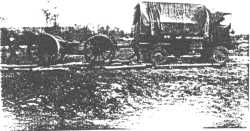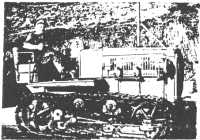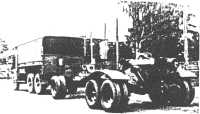The Gun - MechanisationAlthough mechanisation of horse and field artillery did not commence in Britain until about 1928 (1938 in New Zealand), the idea of mechanical traction for moving guns goes back much further. As early as 1782 a M. Cugnot (France) produced a steam carriage designed to tow guns. We have no details of this vehicle; all we do know is that the authorities turned it down. The next 100 years saw other attempts to interest the Generals in steam traction but without success. The horse reigned supreme. Then in 1880 the Fowler Artillery Siege Traction Engine was put through tests at Shoeburyness (UK) in the moving and mounting of siege, ie medium and heavy guns. This vehicle was far ahead of its time and put up an impressive performance, but was not adopted. However, it was successfully used during the South African War (1899 -1902). In 1898 the Scotte Tracteur (France) underwent extensive trials and proved completely superior to animal transport. The French Army requested six for artillery purposes but their government turned them down. The South African War (1899 - 1902) saw the first real attempt by the British to mechanise medium and heavy artillery, at least 15 traction engines being employed in that conflict. Vehicles already mentioned were all steam-driven but by the turn of the century the internal combustion (IC) engine had become a practicable proposition. However, far-sighted Officers of the Regiment who in 1901-02 suggested its development for use in gun towers were not taken seriously. Arguments For and AgainstHere it is pertinent to remark that medium and heavy guns were manned in the field by members of the Royal Garrison Artillery (RGA), who had for some time been known in the Regiment as the Scientific Corps, ie were not averse to adopting new ideas for the betterment of the art. They were not prejudiced against 'mechanical contrivances' as were many of their colleagues in horse and field. Many were the arguments proffered by the last-named gentlemen against the adoption of IC-engined tractors:
IC takes overAt the start of World War 1, steam-driven traction engines continued to be used by the RGA for towing medium and heavy guns with the exception of a few batteries of mediums which were drawn by teams of Clydesdale draught horses. However, as the war progressed IC-engined mechanical transport gradually superseded both horse and steam. By 1916 some medium guns, eg BL 6-in howitzers, were being towed by heavy four-wheel-drive (FWD) IC-engined trucks or Holt Caterpillar tractors, all petrol-driven. The BL 6-in 30-cwt howitzer was replaced later in the war by the BL 6-in 26-cwt, the latter being employed in New Zealand until a premature during CMT training in the early 1950s. The sole attempt at mechanisation of medium artillery in New Zealand prior to 1938 was the purchase of two Model 1925 Holt Caterpillar tractors of American origin. These were fully tracked petrol-driven vehicles, both eventually being held at Fort Dorset, Wellington. During the camping season they were railed to the training camps for the medium artillery batteries, eg Rotorua, Waipukurau, or Waiouru. If guns had to be moved at other times or places, prime movers were hired for the purpose. The Holts ceased to be used shortly after the outbreak of World War 2 when towage of medium guns was undertaken by Leyland trucks previously used to tow QF 3-in 20-cwt AA guns, the latter having been relegated to a static role.
| |
 |
 |
| Somme, July 1916. 6 inch 30 cwt Howitzer being moved into position by a four wheel drive lorry near Mametz. Note that the BL 6-in 30 cwt howitzer was replaced later in the war by the BL 6-in 26-cwt, the latter being employed in New Zealand until a premature during CMT training in the early 1950s. |
Somme 1916. ASC Holt Tractors bringing up 8 inch Howitzers with men taking cover from shell bursts on far side of road, Death Valley, Mametz, July 1916. This shows an early model of Caterpillar tractor which used two wheels in front for steering purposes. In New Zealand two later (Model 1925) fully tracked Holts were obtained during the late 1920s. |
|
When towing a BL 6-in howitzer or BL 60-pr gun, the Holts achieved a maximum speed of about 10 mph (16 kph) on the road, while petrol consumption averaged two miles per gallon (142 litres per 100 km!). For cross-country work, speed was slower and fuel consumption higher. The Holts were reliable, easy to drive and easy to maintain. Even a 'dumb' Gunner could learn all about a Holt in one day. They had no batteries; lighting (headlamps only) was by acetylene gas, while ignition was by magneto. The latter was fitted with an impulse starter which made starting quite easy, two or three turns of the crank handle being sufficient even on a winter's morning at Fort Dorset. Being fully tracked, their cross-country performance was excellent, if rather slow. | |
 |
The author driving one of the Holt Tractors at Fort Dorset in 1938. Note the 'stright pipe' exhaust. The Number 1, who accompanied the Driver, really had to shout to make himself heard! |
|
For mechanical traction the sole modification to gun carriages prior to World War 2 (in New Zealand) was the fitting of rubber pads to the old wooden iron-tyred wheels of World War 1. So the wheels would not fall to pieces, speed was limited to 15 mph (24 kph). After the outbreak of war, local pattern bogies made up from commercial-type truck wheels were fitted. They were not satisfactory; the equipment did not track well and was more difficult to handle in action than the World War 1 version. During World War 2, the 6-in howitzer and 60-pr gun were superseded by the BL 5.5-in and 4.5-in guns respectively. The latter were fitted with heavy pneumatic-tyred wheels designed for mechanical towage.
| |
 |
6-in howitzer on local pattern bogie produced in New Zealand during World War 2. It did not track well, as the trail of smashed one-way bridges around the country amply testified. The tractor is an ex-3-in 20-cwt Leyland. |
|
WL Ruffell previous | index | next | History index | Home | |